|
Hand Grenade Model 1912
This is a high explosive stick grenade, consisting of a fabricated sheet
metal head attached to a wooden handle.
It utilized a grip safety mechanism
that armed a delay fuze when thrown. (Same design as the gas grenade)
A carrying hook is provided for attachment to a soldier's belt.
The grenade shown here, although dated 1914, I believe to be the Model
1912. Also referred to as the "Lantern Head" type, referring to the square head design. |
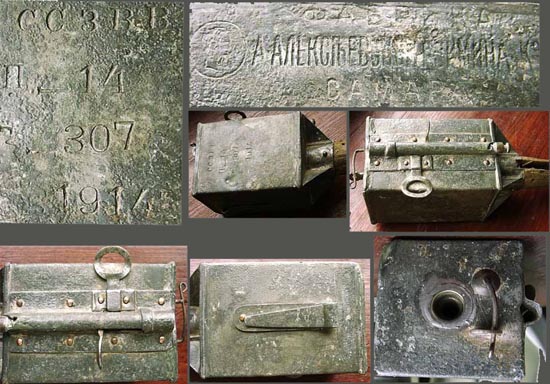
|
|
|
Hand Grenade Model 1914
The Model 1912 was improved upon by eliminating the wood handle,
changing to welded (soldered) sheet metal construction.
The head shape was changed to a cylinder and the belt hook eliminated.
Because of its appearance this grenade
was commonly called the "Bottle Grenade".
The design was modernized later and designated the Model 1914/30.
Other than a change of the explosive filler (Picric Acid to TNT), I don't know what other features may have been modified.
These were used into W.W. II as well.
(Eventually replaced by the RGD-33.)
At right is a Model 1914 grenade and a cross-sectional diagram.
|
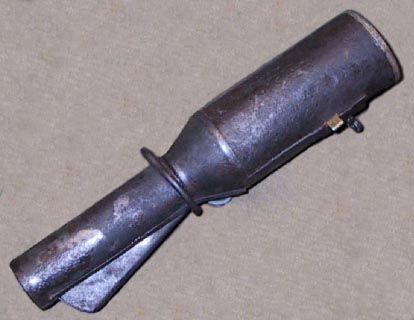 Petrasevitsh, P.: Aselajit ja sotatekniikka.
Petrasevitsh, P.: Aselajit ja sotatekniikka.
Valtion kustannusliike Kirja, Petroskoi 1932
|
|
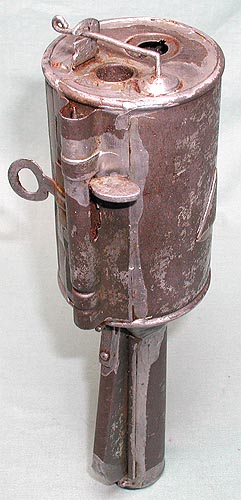
|
Hand Grenade Model 1917 - Gas (Continued)
 The most notable exterior marking for this gas variant is a skull and crossbones logo affixed to the side of the can.
The most notable exterior marking for this gas variant is a skull and crossbones logo affixed to the side of the can.
It translates as "Chemical".
Thanks "Sapper" from Latvia for the translation.
There are two holes in the top of the body. One is a filling hole, which
obviously would be plugged, the other is the open end of an internal fuze well.
The fuze would be an up-side-down "U" shape. One end, with the primer cap, inserted in the exterior tube and the
other, holding a bursting "detonator", inserted in the fuze well. A delay
line between the two would complete the assembly.
The retaining wire at the top locked the fuze assembly in place.
Note that the M1914/30 (See the sectional diagram above.) has
the spring loaded firing pin tube located inside the can.
|
 |
Grenade Function
First, the spring-loaded firing pin is cocked and then locked in position by pushing the ring tab in.
The fuze assembly is then inserted and clamped in place by the cross wire on top. (It pivots back and forth.)
When the soldier grasped the grenade's handle, the hand lever, also
spring operated, pivots and a forked catch grips the stem of the firing
pin, protruding out from the bottom of the small tube.
When ready to throw, the ring-tab is pulled back, unlocking the firing pin.
Throwing the grenade releases the handle lever, pulling
the retaining fork from the firing pin. The pin snaps forward initiating
the fuze delay.
Apparently there is a safety ring missing from this specimen. (See the Model 1914 H.E. picture)
Seems this was a secondary safety in case the grenade was dropped prematurely.
The ring holding the hand lever compressed.
The correct way of grasping the grenade was so that the safety ring went
between the third and fourth finger of the hand. The safety ring was to slide
off the handle as the grenade was thrown and remain in the thrower's hand.
|
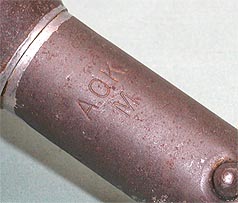 One final detail.
One final detail.
The only other marks found on this grenade are these
stampings on the handle. I'm assuming these are arsenal manufacturing stamps.
|
|
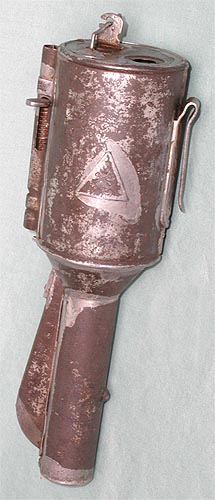


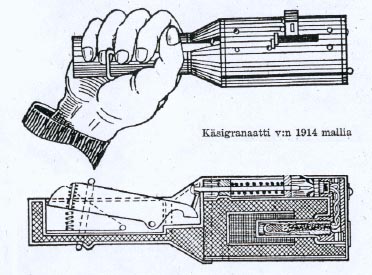

 The most notable exterior marking for this gas variant is a skull and crossbones logo affixed to the side of the can.
The most notable exterior marking for this gas variant is a skull and crossbones logo affixed to the side of the can.
 One final detail.
One final detail.